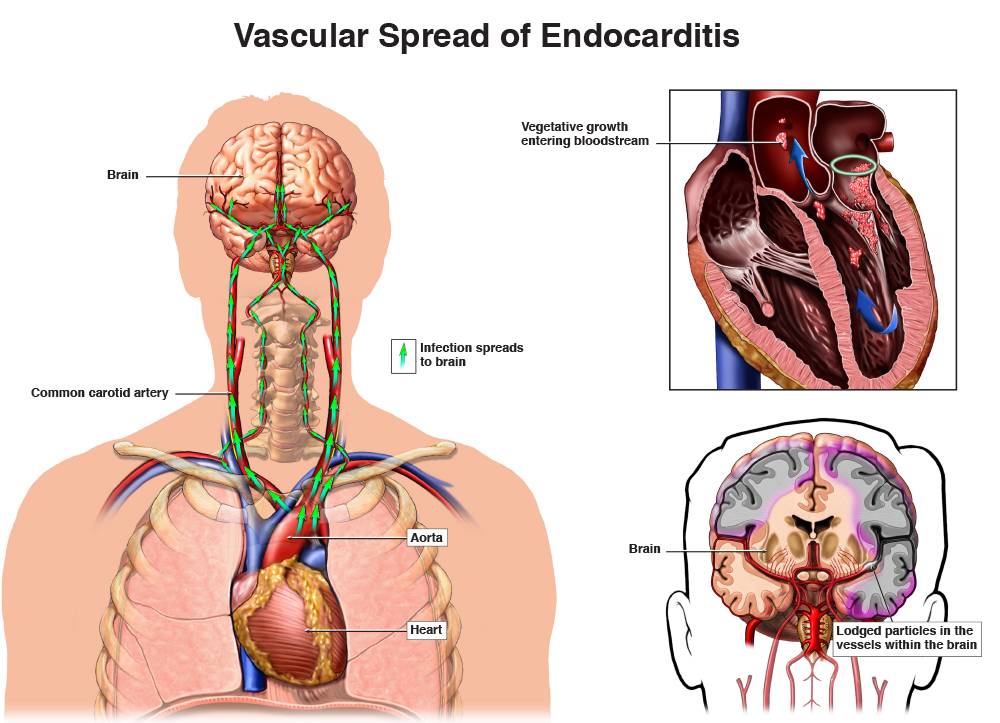What Is Endocarditis?
Endocarditis is an infection of the heart valves and inner lining of the heart. (The inner lining of the heart is called the endocardium.) It is a rare but serious and sometimes fatal illness. Endocarditis can cause growths on the heart valves or inside the heart called vegetations.
Over time, these growths can destroy the heart tissue and valves. They can cause heart failure or problems with the heart rhythm. Vegetations can also cause a stroke if they break away and block an artery in the brain.
Infective Endocarditis
Infective endocarditis starts when a bacteria or another type of germ, like fungi, enters the bloodstream. Your immune system usually destroys harmful germs that enter the bloodstream. However, as some bacteria circulate in your blood and cycle through the heart, they can cause infective endocarditis.
There are two forms of infective endocarditis:
- Acute endocarditis – This form of endocarditis develops suddenly and may become life threatening within days.
- Subacute or chronic – This form develops slowly over a period of weeks to several months.

Symptoms of Endocarditis
Symptoms of endocarditis include the following:
- Fever (102˚ – 104˚)
- Chills
- Fast heart rate or trouble breathing
- Night sweats
- Tiredness
- Aching joints and muscles or weakness
- Swelling in feet, legs, or abdomen
- Weight loss
- Painless red spots on the palms
- Tiny red spots on the skin, under the fingernails, in the whites of your eyes, and inside your mouth
- Blood in the urine
What Causes Endocarditis?


Bacteria normally live on and in your body, such as on your skin, in your mouth, or in your gut. However, bacteria can sometimes make its way into your bloodstream. These are called bacteremia. The bacteria may travel to your heart and settle in the lining of the heart or valves.
There are multiple ways bacteria can enter your bloodstream. A few examples include:
- After a medical or dental test or procedure.
- An infection or other medical condition, such as gum disease or inflammatory bowel disease.
- Having a catheter in your body for long period of time.
- Through needles used for tattooing, body piercing, or intravenous drug use.
Find a Specialist
Who Is at Risk of Getting Endocarditis?
Endocarditis is more likely to develop in people who have:
- a heart defect;
- valve disease, like mitral prolapse or valve damage from an infection such as rheumatic heart disease;
- artificial heart valves;
- intravenous drug use;
- problems with teeth or mouth infections;
- hemodialysis for kidney failure;
- catheter in a vein or blood vessel for a medical procedure; or a
- weak immune system.
How Is Endocarditis Diagnosed?
There are multiple ways a physician can diagnose endocarditis. These include a physical exam and different tests or procedures.
Physical Exam
A health care provider will listen to your heart to check for abnormal heart sounds or murmurs. They will also examine your body for the signs and symptoms, such as red spots on your skin or fingernails.
Tests and Procedures
- Echocardiogram – an ultrasound to see your heart valves and heart structure to look for abnormalities. It can be done by either using a probe that is pressed against your chest wall or by inserting the probe through the mouth and esophagus.
- Electrocardiography (EKG) – checks for your heart rhythm
- Cardiac CT – a series of X-ray images that looks at the heart and other body parts to check if the infection has spread to different areas.
- Blood tests – these can include blood cultures to identify what type of germs are causing endocarditis, blood count, kidney and liver function, and inflammation markers, such as CRP and ESR.
What Treatment Options Are Available for Endocarditis?
Your treatment will depend on what causes your endocarditis. However, there are multiple options. These include the following:
Hospital Stay
You may be in the hospital for a week or more and receive medications in your veins and other areas.
Medications
You may be given antibiotics to treat bacterial infections. This is given through an IV to be more effective against the infection. You may need to be on more than one antibiotic medicine. Treatment may last from two to six weeks. How long you take the antibiotics will depend on how your body responds to the treatment.
We may also use antifungal medication to treat fungal infections. Sometimes your health care provider may recommend lifelong treatment to prevent the infection from returning.
You may also be placed on blood thinners to prevent blood clots from occurring and causing further damage
Surgery
You may require surgery to remove the infected tissue. We may need to replace a damaged heart valve with a prosthetic valve.
Can You Prevent Endocarditis?
There are multiple ways to prevent endocarditis:
- Avoid illegal intravenous drugs.
- Practice careful skin hygiene, such as regularly washing your skin and immediately washing any cuts or scrapes to prevent infection.
- Practice good dental hygiene, including daily brushing and flossing and regular visits to the dentist.
- Take all antibiotics you are prescribed for strep throat or other infections.
You may need to take antibiotics before some medical procedures to prevent endocarditis if you have:
- an artificial heart valve,
- congenital heart defects, or a
- history of infectious endocarditis in the past.
Our Team at University of Utah Health
University of Utah Health has a full-service team that’s here for you from diagnosis to treatment. Our endocarditis health care experts include representatives from internal medicine, infectious disease, cardiovascular medicine, cardiothoracic surgery, behavioral health and addiction medicine, nursing and care management.
Next Steps
If you would like to be evaluated by one of our specialists, you can make an appointment. Our services do not require a referral. However, check with your insurance to see what they require.


Hear From Our Patients
Kirby Barker is no stranger to heart surgery. At the age of 56, he’d already undergone two open-heart operations to replace his aortic valves, stemming from chronic heart conditions. But Kirby came to University of Utah Health for something he couldn’t find anywhere else. a diverse team of skilled specialists collaborate to provide an unprecedented standard of truly personalized care.
For Kirby and his wife, Ruth, these specialists became known as the Kirby Barker Heart Dream Team, performing back-to-back heart valve replacement procedures with remarkable results.
